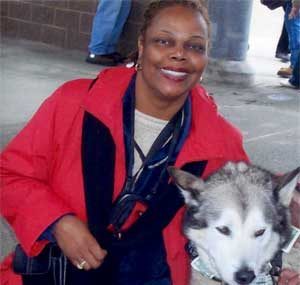M
Leave a Legacy of Giving
You can support our mission of changing lives by saving sight in multiple ways!

Patricia, a retired veteran from the St.
Louis Metro area, was completely blind until she received a cornea transplant.
Patricia, a veteran from Fairview Heights, Illinois, has experienced serious vision problems her entire life, including glaucoma, cataracts, and keratoconus. Keratoconus, according to the National Keratoconus Foundation, “is a non-inflammatory eye condition in which the normally round dome-shaped cornea progressively thins, causing a cone-like bulge to develop.” The disease is rare, affecting 1 in 2,000 people, but it significantly impairs vision, and its cause remains unknown. In 2002, Dr. Gans in St. Louis performed two corneal transplant surgeries on Patricia, which restored her vision. “In the left eye, I had already lost almost all my vision, but we had the transplant to keep the eye healthy,” Patricia explained. “In the right eye, though, from 2002 until May 2013, my vision was wonderful.” She enjoyed healthy vision and an independent life except for driving, which she couldn’t do because of reduced peripheral vision and depthperception. Patricia describes this period as “smooth sailing,” but she admits that it was bittersweet. “I was very happy to get the transplants – grateful that the donor families’ hearts were big enough to give me that wonderful gift – but my heart broke a bit because I knew what sacrifices they had to give,” she said.
Despite a lifetime of vision problems, Patricia was able to pursue a successful career. She served on active duty in the United States Air Force for more than 23 years, working in intelligence and security, before retiring from Scott Air Force Base. “When my son started high school,” she explained, “I promised him he could graduate from that school, so I retired.” Afterward, she worked ten more years as a juvenile probation officer in St. Louis’ Metro East region and retired for good in 2005.
In May 2013, however, Patricia fell face-first onto concrete, knocking loose her cataract implant and damaging the cornea transplant she’d received in her right eye. With the left eye effectively blind, the fall on her right side was debilitating – it left her completely blind. Her face and eye were too damaged from the fall to replace the cornea transplant right away, so she spent most of the summer and early autumn in the Central Blind Rehabilitation Center at Edward Hines, Jr. VA Hospital in Hines, Illinois. In that facility, Patricia learned how to live an independent life in spite of blindness. “They gave me all the tools so I could remain independent,” she said.
In November 2013, Patricia was finally eligible to receive a cornea transplant in her right eye, which rescued her from more than five months of total blindness. “My confidence is getting back to where it’s supposed to be. I’m just kind of the happy go lucky person I was,” she said. “I can sew a little bit, for short periods of time. When I go shopping, I am now able to see the brands. I used to have others help me find things. Now I can do more for myself.” As Patricia’s vision continues to improve, she’ll be able to pursue some of her favorite pastimes: spending time with family, quilting, bowling, reading, and traveling to visit her close military friends across the country. “I look forward to the future of doing the things I used to be able to do,” she said.
Patricia’s experiences have taught her many things. “Be a part of the donor registry,” she suggested. “And make regular appointments to see your eye doctor. It is very important to keep the eyes healthy.” Thanks to her optimism, supportive medical care, her donor families, and following her doctor’s instructions, Patricia is on the road to enjoying her retirement with clear vision.
To join the millions of Americans who have declared their choice to be eye, organ, and tissue donors, sign up for the donor registry at the Donate Life America website or the local Department of Motor Vehicles office.